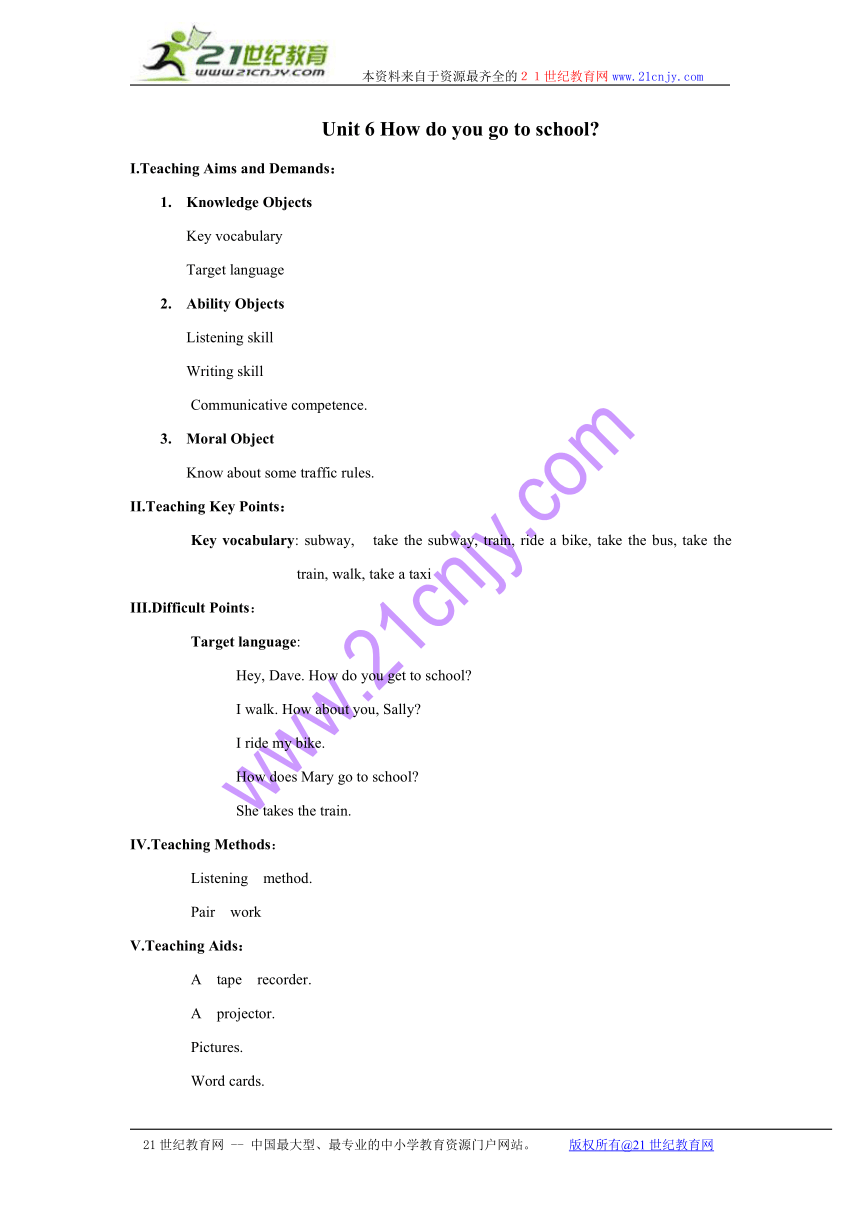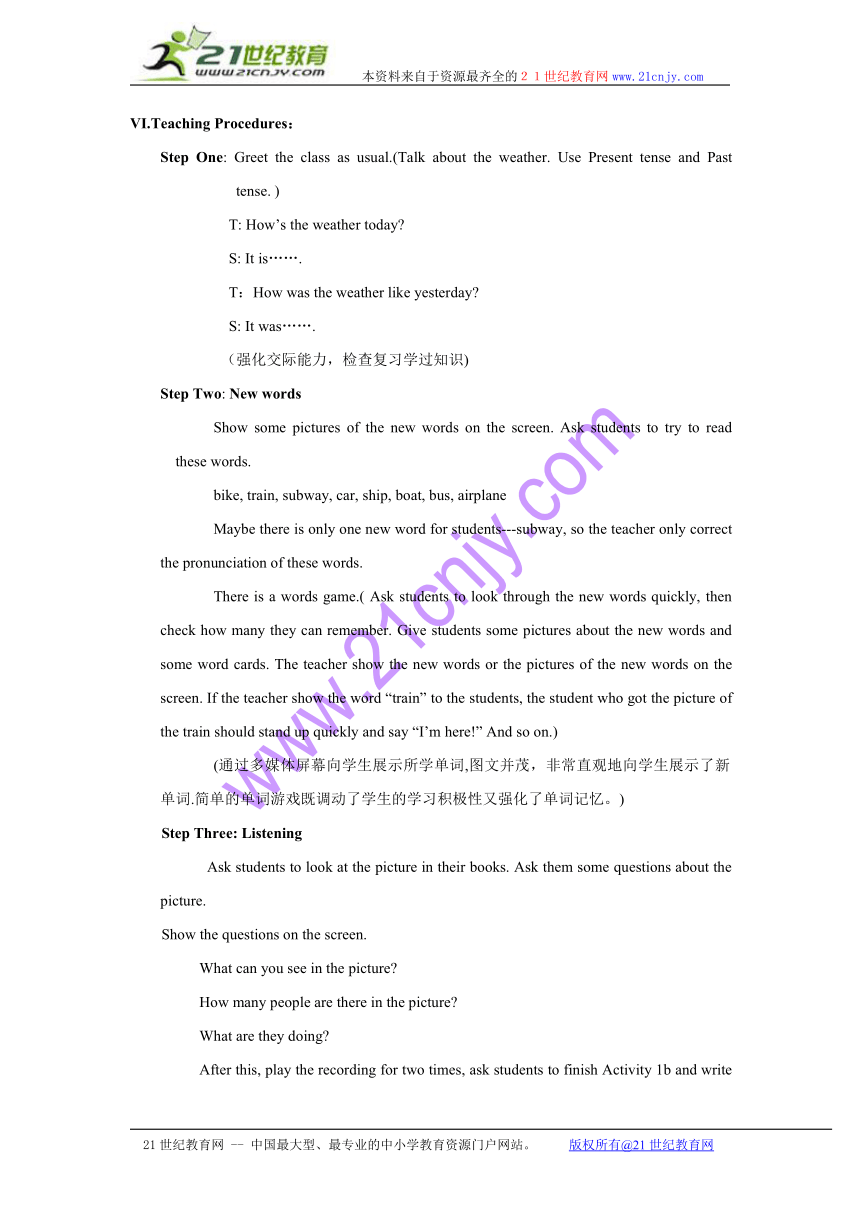英语:unit 6 how do you go to school教案(鲁教版七年级上)
文档属性
| 名称 | 英语:unit 6 how do you go to school教案(鲁教版七年级上) |  | |
| 格式 | rar | ||
| 文件大小 | 13.5KB | ||
| 资源类型 | 教案 | ||
| 版本资源 | 鲁教版(五四学制) | ||
| 科目 | 英语 | ||
| 更新时间 | 2009-10-23 23:54:00 | ||
图片预览


文档简介
本资料来自于资源最齐全的21世纪教育网www.21cnjy.com
Unit 6 How do you go to school
I.Teaching Aims and Demands:
1. Knowledge Objects
Key vocabulary
Target language
2. Ability Objects
Listening skill
Writing skill
Communicative competence.
3. Moral Object
Know about some traffic rules.
II.Teaching Key Points:
Key vocabulary: subway, take the subway, train, ride a bike, take the bus, take the train, walk, take a taxi
III.Difficult Points:
Target language:
Hey, Dave. How do you get to school
I walk. How about you, Sally
I ride my bike.
How does Mary go to school
She takes the train.
IV.Teaching Methods:
Listening method.
Pair work
V.Teaching Aids:
A tape recorder.
A projector.
Pictures.
Word cards.
VI.Teaching Procedures:
Step One: Greet the class as usual.(Talk about the weather. Use Present tense and Past tense. )
T: How’s the weather today
S: It is…….
T:How was the weather like yesterday
S: It was…….
(强化交际能力,检查复习学过知识)
Step Two: New words
Show some pictures of the new words on the screen. Ask students to try to read these words.
bike, train, subway, car, ship, boat, bus, airplane
Maybe there is only one new word for students---subway, so the teacher only correct the pronunciation of these words.
There is a words game.( Ask students to look through the new words quickly, then check how many they can remember. Give students some pictures about the new words and some word cards. The teacher show the new words or the pictures of the new words on the screen. If the teacher show the word “train” to the students, the student who got the picture of the train should stand up quickly and say “I’m here!” And so on.)
(通过多媒体屏幕向学生展示所学单词,图文并茂,非常直观地向学生展示了新单词.简单的单词游戏既调动了学生的学习积极性又强化了单词记忆。)
Step Three: Listening
Ask students to look at the picture in their books. Ask them some questions about the picture.
Show the questions on the screen.
What can you see in the picture
How many people are there in the picture
What are they doing
After this, play the recording for two times, ask students to finish Activity 1b and write down the phrases of the transports.
takes the train, takes the subway, takes the bus
For the third time, ask students to repeat the conversation and check the answers together.
The teacher give the correct answers on the screen.
(通过听力让学生对于本课的基本句型有了一个初步印象,并且让他们自己从听力中领悟怎样表达使用某种交通工具。)
Step Four: Structures
Phrases
take the bus, take the train, take the subway, ride a bike, take a car, take the airplane, take the boat, on foot
Show the pictures to students and read these phrases , ask students to repeat.
Then show the pictures to them and ask them to say each phrase one by one.
(2)Structures:
The teacher show the pictures to students and ask students to answer the question “How do you go to school ” one by one.
Then do another exercise. The first student say “I go to school by ……or I take……to school.”,then the second student say “He/She goes to school by……or He/She takes……to school.”
(让学生通过图片来记短语,生动形象。句子接龙能引起学生的注意,让他们既要考虑自己怎么说还要注意听别人怎么说,而且在这一过程中充分训练了单三人称的句子)
Step Five: Pairwork
Ask two students to read the dialogue in the speech bubbles to the class.
Then ask students to work in pairs. Ask and answer how students get to school in the picture.
As they work, move around the room, offering language or pronunciation support as needed.
Finally ask some pairs of students to present their conversations to the class.
(通过对话让学生更好的掌握所学的句型。)
Step Six: Exercises
1. ( ) do you get to school
I take the bus.
A. Why B. How C. When D. Where
2. How ( ) Dave ( ) to school yester day
A. does; get B. did; got C. does; got D. did; get
3. She goes to the library ( ).
A. walk B. on foot C. by foot D. in foot
4. How ( ) Tom and Marry ( ) home
A. do; get to B. does; get to C. do; get D. does; get
(通过练习巩固所学内容,特别是练习3强调了步行用“on foot”练习4强调了地点副词“home”前不用介词“to”)
Homework:
Write down your own conversations in pairwork.
Interview ten students how they get to someplace, make a list.
VII.教学反思:
21世纪教育网 -- 中国最大型、最专业的中小学教育资源门户网站。 版权所有@21世纪教育网
Unit 6 How do you go to school
I.Teaching Aims and Demands:
1. Knowledge Objects
Key vocabulary
Target language
2. Ability Objects
Listening skill
Writing skill
Communicative competence.
3. Moral Object
Know about some traffic rules.
II.Teaching Key Points:
Key vocabulary: subway, take the subway, train, ride a bike, take the bus, take the train, walk, take a taxi
III.Difficult Points:
Target language:
Hey, Dave. How do you get to school
I walk. How about you, Sally
I ride my bike.
How does Mary go to school
She takes the train.
IV.Teaching Methods:
Listening method.
Pair work
V.Teaching Aids:
A tape recorder.
A projector.
Pictures.
Word cards.
VI.Teaching Procedures:
Step One: Greet the class as usual.(Talk about the weather. Use Present tense and Past tense. )
T: How’s the weather today
S: It is…….
T:How was the weather like yesterday
S: It was…….
(强化交际能力,检查复习学过知识)
Step Two: New words
Show some pictures of the new words on the screen. Ask students to try to read these words.
bike, train, subway, car, ship, boat, bus, airplane
Maybe there is only one new word for students---subway, so the teacher only correct the pronunciation of these words.
There is a words game.( Ask students to look through the new words quickly, then check how many they can remember. Give students some pictures about the new words and some word cards. The teacher show the new words or the pictures of the new words on the screen. If the teacher show the word “train” to the students, the student who got the picture of the train should stand up quickly and say “I’m here!” And so on.)
(通过多媒体屏幕向学生展示所学单词,图文并茂,非常直观地向学生展示了新单词.简单的单词游戏既调动了学生的学习积极性又强化了单词记忆。)
Step Three: Listening
Ask students to look at the picture in their books. Ask them some questions about the picture.
Show the questions on the screen.
What can you see in the picture
How many people are there in the picture
What are they doing
After this, play the recording for two times, ask students to finish Activity 1b and write down the phrases of the transports.
takes the train, takes the subway, takes the bus
For the third time, ask students to repeat the conversation and check the answers together.
The teacher give the correct answers on the screen.
(通过听力让学生对于本课的基本句型有了一个初步印象,并且让他们自己从听力中领悟怎样表达使用某种交通工具。)
Step Four: Structures
Phrases
take the bus, take the train, take the subway, ride a bike, take a car, take the airplane, take the boat, on foot
Show the pictures to students and read these phrases , ask students to repeat.
Then show the pictures to them and ask them to say each phrase one by one.
(2)Structures:
The teacher show the pictures to students and ask students to answer the question “How do you go to school ” one by one.
Then do another exercise. The first student say “I go to school by ……or I take……to school.”,then the second student say “He/She goes to school by……or He/She takes……to school.”
(让学生通过图片来记短语,生动形象。句子接龙能引起学生的注意,让他们既要考虑自己怎么说还要注意听别人怎么说,而且在这一过程中充分训练了单三人称的句子)
Step Five: Pairwork
Ask two students to read the dialogue in the speech bubbles to the class.
Then ask students to work in pairs. Ask and answer how students get to school in the picture.
As they work, move around the room, offering language or pronunciation support as needed.
Finally ask some pairs of students to present their conversations to the class.
(通过对话让学生更好的掌握所学的句型。)
Step Six: Exercises
1. ( ) do you get to school
I take the bus.
A. Why B. How C. When D. Where
2. How ( ) Dave ( ) to school yester day
A. does; get B. did; got C. does; got D. did; get
3. She goes to the library ( ).
A. walk B. on foot C. by foot D. in foot
4. How ( ) Tom and Marry ( ) home
A. do; get to B. does; get to C. do; get D. does; get
(通过练习巩固所学内容,特别是练习3强调了步行用“on foot”练习4强调了地点副词“home”前不用介词“to”)
Homework:
Write down your own conversations in pairwork.
Interview ten students how they get to someplace, make a list.
VII.教学反思:
21世纪教育网 -- 中国最大型、最专业的中小学教育资源门户网站。 版权所有@21世纪教育网
同课章节目录
- Unit 1 What does he look like?
- Section A
- Section B
- Unit 2 I'd like some noodles.
- Section A
- Section B
- Unit 3 How was your school trip?
- Section A
- Section B
- Unit 4 What did you do last weekend?
- Section A
- Section B
- Unit 5 Where did you go on vacation?
- Section A
- Section B
- Unit 6 How often do you exercise?
- Section A
- Section B
- Unit 7 I'm more outgoing than my sister.
- Section A
- Section B
- Unit 8 What's the best movie theater?
- Section A
- Section B
